
The western yellow wagtail is a small passerine in the wagtail family Motacillidae, which also includes the pipits and longclaws.
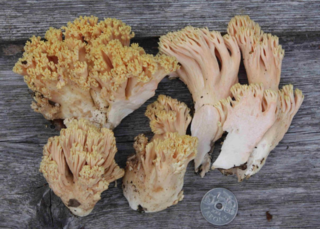
Ramaria formosa, commonly known as the salmon coral, beautiful clavaria, handsome clavaria, yellow-tipped- or pink coral fungus, is a coral fungus found in Europe. It is widely held to be mildly poisonous if consumed, giving rise to acute gastrointestinal symptoms of nausea, vomiting, diarrhea and colicky pain. It is a pinkish, much-branched coral-shape reaching some 20 cm (8 in) high. Similar forms collected in North America are now considered to represent a different species than the European Ramaria formosa.

The genus Ramaria comprises approximately 200 species of coral fungi. Several, such as Ramaria flava, are edible and picked in Europe, though they are easily confused with several mildly poisonous species capable of causing nausea, vomiting, and diarrhea; these include R. formosa and R. pallida. Three Ramaria species have been demonstrated to contain a very unusual organoarsenic compound homoarsenocholine.
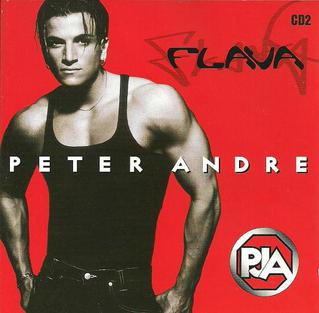
"Flava" is a song by English-Australian singer Peter Andre, released as the fifth single from his second studio album, Natural (1996). It includes a rap by American rapper Cee. The song spent one week at number one on the UK Singles Chart in September 1996, becoming Andre's first number-one single in the UK. "Flava" also reached top 10 in Denmark, the Netherlands, New Zealand, Sweden, and the Wallonia region of Belgium.

Ramaria botrytis, commonly known as the clustered coral, the pink-tipped coral mushroom, or the cauliflower coral, is an edible species of coral fungus in the family Gomphaceae. Its robust fruit body can grow up to 15 cm (6 in) in diameter and 20 cm (8 in) tall, and resembles some marine coral. Its dense branches, which originate from a stout, massive base, are swollen at the tips and divided into several small branchlets. The branches are initially whitish but age to buff or tan, with tips that are pink to reddish. The flesh is thick and white. The spores, yellowish in deposit, are ellipsoid, feature longitudinal striations, and measure about 13.8 by 4.7 micrometers.

The clavarioid fungi are a group of fungi in the Basidiomycota typically having erect, simple or branched basidiocarps that are formed on the ground, on decaying vegetation, or on dead wood. They are colloquially called club fungi and coral fungi.
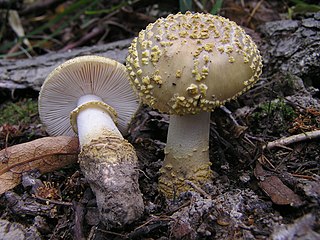
Amanita franchetii, also known as the Franchet's amanita, is a species of fungus in the family Amanitaceae. It was given its current name by Swiss mycologist Victor Fayod in 1889 in honor of French botanist Adrien René Franchet. A. franchetii occurs in Europe and North Africa with oaks, chestnuts, and pines.
Zenji flava is a common nickname for Zanzibari hip hop, a genre that began to develop in the 1990s. The name is made of zenji, which is slang for "Zanzibar", and flava, which is a corruption of "flavour", thus meaning "of Zanzibari taste". As with bongo flava, i.e., Tanzanian mainland's hip hop, zenji flava is usually sung in swahili; the main difference between the two subgenres is that Zanzibari hip hop also reflects some influence of taarab, and thus indirectly of Arab music and Indian music. Notable zenji flava artists include Ali Haji. As Zenji flavour goes on it find itself as a sub part of Bongo flava as it has influence from the young generation of artists who want to cop with Bongo flava. like Offside trick, 2 berry now is separated to form two solo artists, Wazenji kijiwe and Shaka zulu, others are East connection which was made up with almost seven groups of artist including Offside trick Brooklyn, Four nature, Jumbo camp, Queen love, and K jam. It was in this time that Zenji flava was modernized with rapid growth in the number of artists.

George Francis Atkinson was an American botanist and mycologist.

Ramaria flaccida is a species of coral fungus in the family Gomphaceae. Originally described as Clavaria flaccida by Elias Fries in 1821, the species was transferred to Ramaria by Hubert Bourdot in 1898.

Phaeoclavulina abietina, commonly known as the green-staining coral, is a coral mushroom in the family Gomphaceae. It is characterized by the green staining reaction it develops in response to bruising or injury.
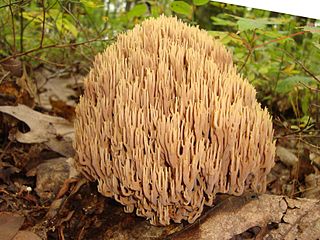
Ramaria stricta, commonly known as the strict-branch coral is a coral fungus of the genus Ramaria. It has a cosmopolitan distribution, and grows on dead wood, stumps, trunks, and branches of both deciduous and coniferous trees. Its fruit body is up to 10 cm tall, made of multiple slender, compact, and vertical parallel branches. Its color is typically light tan to vinaceous-brown. All parts of the mushroom will bruise when handled. There are several lookalike corals that can usually be distinguished from R. stricta by differences in coloration, bruising reaction, or microscopic features. The fungus is inedible due to its unpleasant odor and bitter taste.

Ramaria araiospora, commonly known as the red coral, is a coral mushroom in the family Gomphaceae. First described in 1974, it is found in North America, and the Himalaya. An edible species, it is sold in local markets in Mexico.
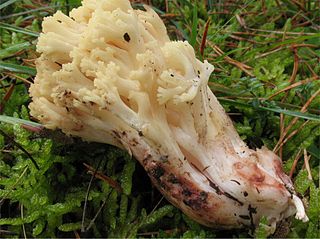
Ramaria sanguinea, commonly known as the bleeding coral or the bloody coral, is a coral mushroom in the family Gomphaceae.

Ramaria rielii is a European species of coral fungus in the family Gomphaceae. It was described in 1897 by Jean Louis Émile Boudier. It is quite similar in appearance to the more common and widely distributed Ramaria botrytis, but can be distinguished from that species by the lack of clamped hyphae, its longer and wider spores, and warts instead of striations on the spore surface.

Ramaria gracilis is a species of coral fungus in the family Gomphaceae.

Ramaria aurea is a coral mushroom in the family Gomphaceae. It is found in North America and Europe. It is similar to R. flava; both species are edible.

Ramaria flavosaponaria is a species of coral fungus in the family Gomphaceae. It is found in the mountains of eastern North America from Georgia and Tennessee to Nova Scotia.
















